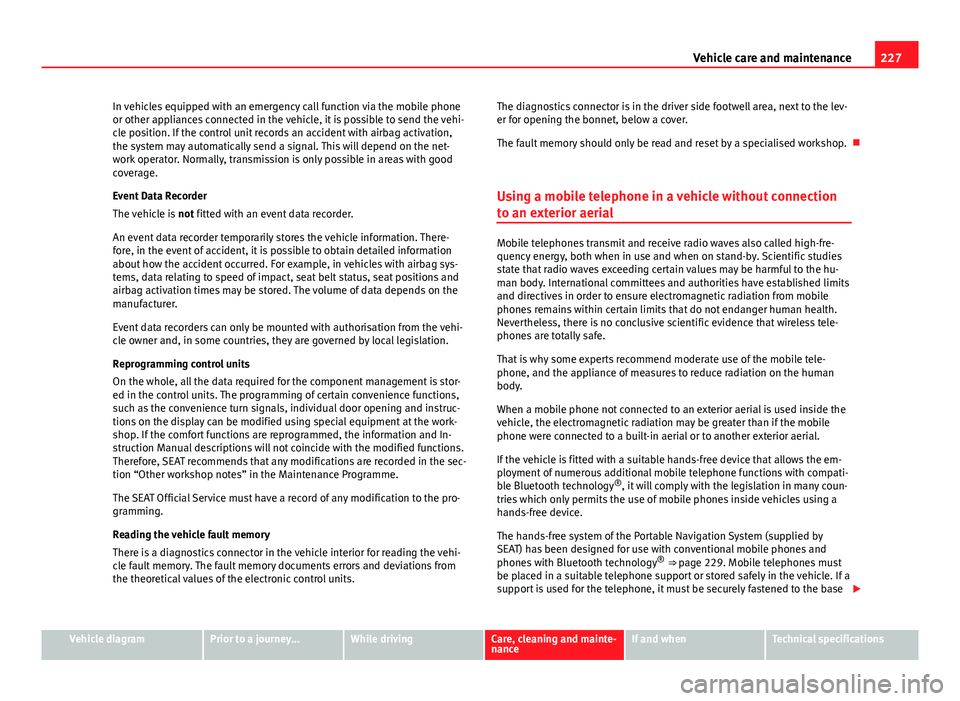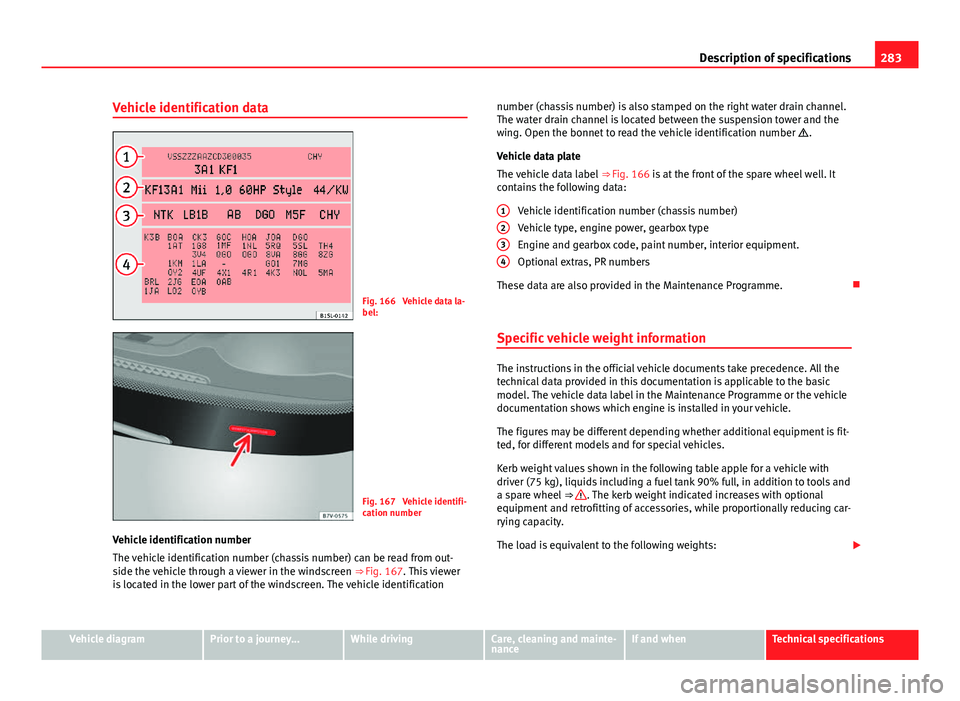Maintenance Programme Seat Mii 2013 User Guide
[x] Cancel search | Manufacturer: SEAT, Model Year: 2013, Model line: Mii, Model: Seat Mii 2013Pages: 306, PDF Size: 4.3 MB
Page 229 of 306

227
Vehicle care and maintenance
In vehicles equipped with an emergency call function via the mobile phone
or other appliances connected in the vehicle, it is possible to send the vehi-
cle position. If the control unit records an accident with airbag activation,
the system may automatically send a signal. This will depend on the net-
work operator. Normally, transmission is only possible in areas with good
coverage.
Event Data Recorder
The vehicle is not fitted with an event data recorder.
An event data recorder temporarily stores the vehicle information. There-
fore, in the event of accident, it is possible to obtain detailed information
about how the accident occurred. For example, in vehicles with airbag sys-
tems, data relating to speed of impact, seat belt status, seat positions and
airbag activation times may be stored. The volume of data depends on the
manufacturer.
Event data recorders can only be mounted with authorisation from the vehi-
cle owner and, in some countries, they are governed by local legislation.
Reprogramming control units
On the whole, all the data required for the component management is stor-
ed in the control units. The programming of certain convenience functions,
such as the convenience turn signals, individual door opening and instruc-
tions on the display can be modified using special equipment at the work-
shop. If the comfort functions are reprogrammed, the information and In-
struction Manual descriptions will not coincide with the modified functions.
Therefore, SEAT recommends that any modifications are recorded in the sec-
tion “Other workshop notes” in the Maintenance Programme.
The SEAT Official Service must have a record of any modification to the pro-
gramming.
Reading the vehicle fault memory
There is a diagnostics connector in the vehicle interior for reading the vehi-
cle fault memory. The fault memory documents errors and deviations from
the theoretical values of the electronic control units. The diagnostics connector is in the driver side footwell area, next to the lev-
er for opening the bonnet, below a cover.
The fault memory should only be read and reset by a specialised workshop.
Using a mobile telephone in a vehicle without connection
to an exterior aerial
Mobile telephones transmit and receive radio waves also called high-fre-
quency energy, both when in use and when on stand-by. Scientific studies
state that radio waves exceeding certain values may be harmful to the hu-
man body. International committees and authorities have established limits
and directives in order to ensure electromagnetic radiation from mobile
phones remains within certain limits that do not endanger human health.
Nevertheless, there is no conclusive scientific evidence that wireless tele-
phones are totally safe.
That is why some experts recommend moderate use of the mobile tele-
phone, and the appliance of measures to reduce radiation on the human
body.
When a mobile phone not connected to an exterior aerial is used inside the
vehicle, the electromagnetic radiation may be greater than if the mobile
phone were connected to a built-in aerial or to another exterior aerial.
If the vehicle is fitted with a suitable hands-free device that allows the em-
ployment of numerous additional mobile telephone functions with compati-
ble Bluetooth technology ®
, it will comply with the legislation in many coun-
tries which only permits the use of mobile phones inside vehicles using a
hands-free device.
The hands-free system of the Portable Navigation System (supplied by
SEAT) has been designed for use with conventional mobile phones and
phones with Bluetooth technology ®
⇒ page 229. Mobile telephones must
be placed in a suitable telephone support or stored safely in the vehicle. If a
support is used for the telephone, it must be securely fastened to the base
Vehicle diagramPrior to a journey...While drivingCare, cleaning and mainte-
nanceIf and whenTechnical specifications
Page 235 of 306

233
Vehicle care and maintenance
Notes for the user Introduction
Additional information and warnings:
● Exterior detail ⇒ page 6
● Accessories, parts replacement, repairs and modifications ⇒ page 222
● ⇒ Booklet Maintenance Programme
WARNING
Failure to treat the vehicle with the correct care increases the risk of acci-
dent and injury.
● Observe legal requirements.
● Observe the Instruction Manual.
CAUTION
If you do not treat the vehicle suitably, you may cause it to be damaged.
● Observe legal requirements.
● Carry out regular maintenance of the vehicle, according to specifications
in the Maintenance Programme.
● Observe the Instruction Manual. Labels and plates
Fig. 132 Warnings relat-
ing to handling of the
City Safety Assist system
laser sensor function
Some parts in the engine compartment come from the factory with certifi-
cates of safety, labels or plates containing important information regarding
the operation of the vehicle, for example, on the petrol cap, on the passeng-
er's sun visor, on the driver door strut, or on the floor of the luggage com-
partment.
● Never remove these certificates of safety, labels or plates, and ensure
they are kept in good condition and are legible.
● If a vehicle part, bearing a certificate of safety, label or plate, is re-
placed, the specialised workshop should attach the information back in the
same place.
Certificate of safety
A certificate of safety on the door strut states that all the safety standards
and regulations established by the national traffic authorities responsible
for road safety were met at the time of manufacture. It may also give the
month and year of manufacture, together with the chassis number.
Vehicle diagramPrior to a journey...While drivingCare, cleaning and mainte-
nanceIf and whenTechnical specifications
Page 285 of 306

283
Description of specifications
Vehicle identification data
Fig. 166 Vehicle data la-
bel:
Fig. 167 Vehicle identifi-
cation number
Vehicle identification number
The vehicle identification number (chassis number) can be read from out-
side the vehicle through a viewer in the windscreen ⇒ Fig. 167. This viewer
is located in the lower part of the windscreen. The vehicle identification number (chassis number) is also stamped on the right water drain channel.
The water drain channel is located between the suspension tower and the
wing. Open the bonnet to read the vehicle identification number
.
Vehicle data plate
The vehicle data label ⇒ Fig. 166 is at the front of the spare wheel well. It
contains the following data:
Vehicle identification number (chassis number)
Vehicle type, engine power, gearbox type
Engine and gearbox code, paint number, interior equipment.
Optional extras, PR numbers
These data are also provided in the Maintenance Programme.
Specific vehicle weight information
The instructions in the official vehicle documents take precedence. All the
technical data provided in this documentation is applicable to the basic
model. The vehicle data label in the Maintenance Programme or the vehicle
documentation shows which engine is installed in your vehicle.
The figures may be different depending whether additional equipment is fit-
ted, for different models and for special vehicles.
Kerb weight values shown in the following table apple for a vehicle with
driver (75 kg), liquids including a fuel tank 90% full, in addition to tools and
a spare wheel ⇒
. The kerb weight indicated increases with optional
equipment and retrofitting of accessories, while proportionally reducing car-
rying capacity.
The load is equivalent to the following weights:
1
234
Vehicle diagramPrior to a journey...While drivingCare, cleaning and mainte-
nanceIf and whenTechnical specifications